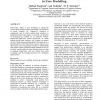Free Online Productivity Tools
i2Speak
i2Symbol
i2OCR
iTex2Img
iWeb2Print
iWeb2Shot
i2Type
iPdf2Split
iPdf2Merge
i2Bopomofo
i2Arabic
i2Style
i2Image
i2PDF
iLatex2Rtf
Sci2ools
IUI
1997
ACM
1997
ACM
Helping Users Think in Three Dimensions: Steps Toward Incorporating Spatial Cognition in User Modelling
Historically, efforts at user modelling in educational systems have tended to employ knowledge representations in which symbolic (or "linguistic") cognition is emphasized, and in which spatial/visual cognition is underrepresented. In this paper, we describe our progress in developing user models for an explicitly "spatial" educational application named HyperGami, in which students design (and construct, out of paper) an endless variety of three-dimensional polyhedra. This paper gives a brief description of the HyperGami system; discusses our observations (and experimental results) in understanding what makes certain polyhedral shapes difficult or easy to visualize; and describes the ideas through which we plan to augment HyperGami with user models that could eventually form the computational basis for "intelligent spatial critics." Important as these "linguistic" representations of knowledge are, there is an increasing body of evidence to sugges...
Intelligent Spatial Critics | IUI 1997 | Software Engineering | Spatial/visual Cognition | User Models |
| Added | 06 Aug 2010 |
| Updated | 06 Aug 2010 |
| Type | Conference |
| Year | 1997 |
| Where | IUI |
| Authors | Michael Eisenberg, Ann Nishioka, M. E. Schreiner |
Comments (0)

